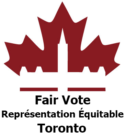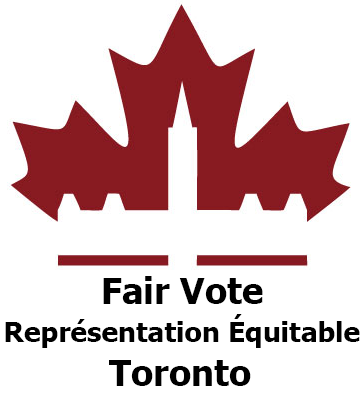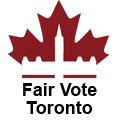
Here are the most common questions people have when they are considering supporting proportional representation:
1. Will it still be easy to vote?

Actually, ballots under proportional systems won’t look much different at all. For instance, Ballots could be one vote or two, include ranking or not. At the top of the page are two examples.
2. Would we still have the same number of MPs?

The number of MPs would not change significantly or at all.
3. Would the number of MPs per province stay the same?

PR will not affect MP allocations. The number of MPs per province would stay the same.
4. Would we still have ridings and local representation?

In fact, voters will actually get more choice, as you will see below.
But how does it work?
Here is a very simplified explanation of how a proportional voting system works.
Under our current voting system, we can only elect one member per riding. There is no way to achieve proportional results because only one person can win, making it possible for one party to dominate a region. The red MPs below won in all three ridings.

Under a proportional voting system, ridings will be combined so that each riding results in more than one winner. For instance, if you combine three ridings, then it can be possible to elect three MPs from different parties by considering all the top winners.

For example, let’s assume we have a province with 9 MPs, and therefore 3 ridings. Let’s also assume the first winner in every riding is still red so they now have 3 MPs in the province. If 34% of voters voted red, then that’s all the MPs they get.
The second and third MPs would be elected depending on the proportion of votes for the entire province. For instance if 33% of voters in the province voted blue, then they would also elect 1 MP in each riding for a total of 3 MPs.
If 22% of voters in the province voted purple, then the 2 ridings with the highest purple votes would get a purple MP.
And if 11% of voters in the province voted yellow, the riding with the highest yellow votes would get a yellow MP.
As a result, proportionality has been achieved. Voters will also have 3 MPs in their riding that they can choose to approach with their concerns, instead of only one MP who may not share their views.
There are other considerations that have to be taken into account to make sure the results are proportional, but having larger ridings with more than one MP is the basic foundation upon which proportional systems are designed.
First, adopt PR, then decide on the system.
The important thing is that we first decide to adopt the principle of proportional representation to ensure that everyone gets the representation they vote for. The next step would be to take the time to decide on and design the best system for Canada.
The advantage of proportional systems is there are many ways that they can be customized to give good local and proportional results, because in the end it is just math.
If you want to get into more detail on the specifics of different systems, you can learn about the three most popular options for Canada, some of which are already in use in other countries, Mixed Member Proportional, Single Transferable Vote and Dual Member Proportional.
What else will change?
Here are some things that will also be a little different under proportional representation:
- More time required to calculate the election results and ensure proportionality.
- More time required for negotiation in order to form establish government coalitions and partnerships.
- More time required for meaningful policy-making involving multi-partisan collaboration.
It’s time to support the adoption of proportional representation for our elections in Canada. Sign the Declaration of Voters’ Rights on Fair Vote Canada’s website, and get added to the mailing list. We willl keep you updated on national and local activities.











